ALLIES ASSAULT ITALIAN MAINLAND AT SALERNO
Salerno, Italy · September 9, 1943
On this date in 1943 in Italy, the Allies from their strongholds in North Africa and Sicily invaded the Italian mainland at Salerno south of Naples (Operation Avalanche), with diversionary landings at Calabria (Operation Baytown, September 3, 1943), which lay on the “toe” of the Italian Peninsula, and Taranto (Operation Slapstick, September 9), which lay in the “instep” of the Italian heel (see map). (A landing near the Italian capital, Rome, would have been too far from Allied air support based in Sicily.) Allied bombing missions during the first week of September softened up the Salerno beaches and plain. In landing on the Italian mainland U.S. forces were returning to the European continent for the first time since 1918. The day before the Salerno assault, September 8, both Gen. Dwight D. Eisenhower, Supreme Allied Commander, and Marshal of Italy Pietro Badoglio, former Chief of Staff of the Italian Army and now Benito Mussolini’s replacement as head of state, publicly announced Italy’s unconditional surrender, though the two sides had negotiated surrender terms five days earlier. Immediately, King Victor Emmanuel III and the Italian high command forsook Rome for the safety of Bari, directly north of Taranto. After Mussolini’s fall from power the previous July, Adolf Hitler had declared the Italians to be the “bitterest enemy.” He directed his armed forces to take over the defense of Italy and occupy Rome, funneling fresh divisions from Austria through the Brenner Pass into Italy since the start of August—this as a resurgent Red Army made gains on Germany’s Eastern Front. Three days later, on September 12, German commandos snatched Mussolini from Italian captivity high in the Apennine Mountains and set the Duce up as head of a puppet government in Northern Italy, the Italian Social Republic (Repubblica Sociale Italiana). The invasion of the Italian mainland unleashed 20 months of confusing and murderous turmoil in Italy between Axis and Allied armies and Fascists and anti-Fascists. On April 27, 1945, as Allied troops advanced through Northern Italy, Italian partisans captured Mussolini trying to escape to Switzerland, executed him the next day, and hung his corpse, along with a half-dozen other Fascists, from the girder of a gas station in the Piazzale Loreto in Milan.
[amazon_carousel widget_type=”ASINList” width=”600″ height=”200″ title=”Recommended Reading” market_place=”US” shuffle_products=”False” show_border=”False” asin=”1780962495,0307888002,0945575041,0374205183,080508861X,1591145759,1844860590,1844150984,0306806886,0199219346″ /]
Allied Invasion of Mainland Italy, September 1943
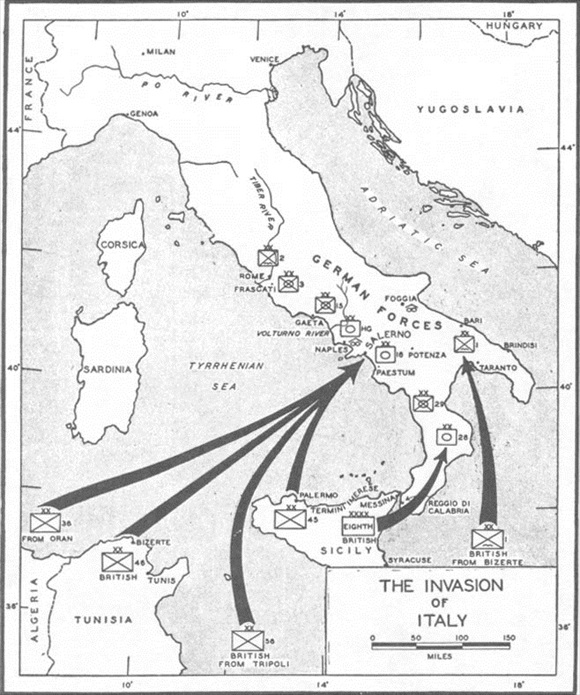 |
Above: Breaching Hitler’s “Fortress Europe.” Once established on the Italian mainland, the Allies hoped to secure complete naval and aerial domination of the Mediterranean, secure strategic ports and airfields for future operations against Fortress Europe, knock Italy out of the war, and force the Germans to retreat north of the Alps.
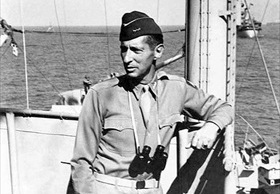 | 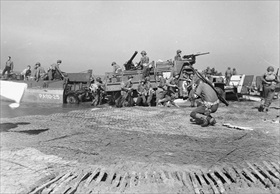 |
Left: Lt. Gen. Mark Clark, Commanding General, U.S. Fifth Army on board USS Ancon during the landings at Salerno, September 12, 1943. Clark’s conduct of operations throughout the Italian campaign is controversial, but Gen. Dwight D. Eisenhower considered him a brilliant staff officer and trainer. Clark won many awards, including the Distinguished Service Cross for extreme bravery in war, subordinate only to the Medal of Honor.
![]()
Right: Artillery being landed during the invasion of mainland Italy at Salerno, September 1943. By sundown on D‑Day, more than 50,000 Allies (out of a total of 189,000 on September 16) were ashore and had pushed inland as much as eight miles. Their intention was to cross the level Salerno plain, cross over the foothills to the mountain passes and through them to Naples, where they could use its port and airfields as a base for future operations in Italy.
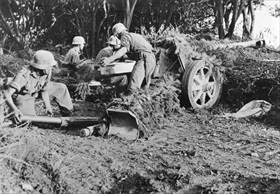 | 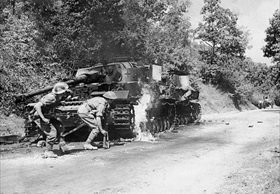 |
Left: The Allies projected that the Germans might have 39,000 men facing them on D‑Day but on D+3 would have a force of 100,000. The Germans succeeded in placing mortars and artillery (like the one shown in this photo) on the high ground in a semicircle covering the whole coastal area. On September 13, “Black Monday,” Gen. Mark Clark’s Fifth Army, pinned down to a bridgehead, desperately tried clawing its way out of the jaws of defeat. By the next night the crisis had passed with the assistance of airborne reinforcements.
![]()
Right: The Salerno beachhead was secured at the cost of 12,500 Allied casualties and MIAs on September 16, 1943. On that date Gen. Bernard Montgomery’s British Eighth Army, moving up from the south, linked up with Clark’s Fifth Army. On September 19 the Americans pushed northwest towards Naples. In this photo from September 22, 1943, men of the 2/6th Queens’s Regiment advance past a burning German IV tank in the Salerno area. The regiment saw heavy fighting at Salerno, Monte Casino, and Anzio.
Allied Landings at Salerno, September 9, 1943
![]()

 History buffs, there is good news! The Daily Chronicles of World War II is now available as an ebook for $4.99 on Amazon.com. Containing a year’s worth of dated entries from this website, the ebook brings the story of this tumultuous era to life in a compelling, authoritative, and succinct manner. Featuring inventive navigation aids, the ebook enables readers to instantly move forward or backward by month and date to different dated entries. Simple and elegant! Click
History buffs, there is good news! The Daily Chronicles of World War II is now available as an ebook for $4.99 on Amazon.com. Containing a year’s worth of dated entries from this website, the ebook brings the story of this tumultuous era to life in a compelling, authoritative, and succinct manner. Featuring inventive navigation aids, the ebook enables readers to instantly move forward or backward by month and date to different dated entries. Simple and elegant! Click 











